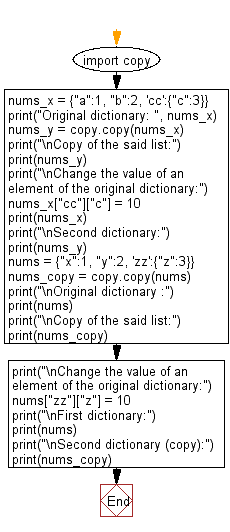Python: Create a shallow copy of a given dictionary
3. Shallow Copy of Dictionary
Write a Python program to create a shallow copy of a given dictionary. Use copy.copy
Sample Solution:
Python Code:
import copy
nums_x = {"a":1, "b":2, 'cc':{"c":3}}
print("Original dictionary: ", nums_x)
nums_y = copy.copy(nums_x)
print("\nCopy of the said list:")
print(nums_y)
print("\nChange the value of an element of the original dictionary:")
nums_x["cc"]["c"] = 10
print(nums_x)
print("\nSecond dictionary:")
print(nums_y)
nums = {"x":1, "y":2, 'zz':{"z":3}}
nums_copy = copy.copy(nums)
print("\nOriginal dictionary :")
print(nums)
print("\nCopy of the said list:")
print(nums_copy)
print("\nChange the value of an element of the original dictionary:")
nums["zz"]["z"] = 10
print("\nFirst dictionary:")
print(nums)
print("\nSecond dictionary (copy):")
print(nums_copy)
Sample Output:
Original dictionary: {'a': 1, 'b': 2, 'cc': {'c': 3}}
Copy of the said list:
{'a': 1, 'b': 2, 'cc': {'c': 3}}
Change the value of an element of the original dictionary:
{'a': 1, 'b': 2, 'cc': {'c': 10}}
Second dictionary:
{'a': 1, 'b': 2, 'cc': {'c': 10}}
Original dictionary :
{'x': 1, 'y': 2, 'zz': {'z': 3}}
Copy of the said list:
{'x': 1, 'y': 2, 'zz': {'z': 3}}
Change the value of an element of the original dictionary:
First dictionary:
{'x': 1, 'y': 2, 'zz': {'z': 10}}
Second dictionary (copy):
{'x': 1, 'y': 2, 'zz': {'z': 10}}
Flowchart:

For more Practice: Solve these Related Problems:
- Write a Python program to create a shallow copy of a dictionary using copy.copy, then update a value in a nested mutable object and print both dictionaries to observe the shared reference.
- Write a Python function that takes a dictionary, creates a shallow copy with copy.copy, and then prints both the original and the copy to demonstrate that top-level keys are distinct while nested objects are shared.
- Write a Python script to compare the memory addresses (using id()) of both the original dictionary and its shallow copy, particularly focusing on nested mutable values.
- Write a Python program to create a shallow copy of a dictionary and then remove a key from the original, printing both dictionaries to show that the copy remains unchanged.
Go to:
Previous: Write a Python program to create a deep copy of a given list.
Next: Write a Python program to create a deep copy of a given dictionary.
Python Code Editor:
Have another way to solve this solution? Contribute your code (and comments) through Disqus.
What is the difficulty level of this exercise?
Test your Programming skills with w3resource's quiz.
